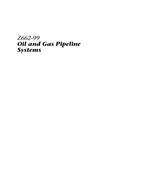Click here to purchase
This is a searchable PDF.
1. Scope
1.1 This Standard covers the design, construction, operation, a nd maintenance of oil and gas industry pipeline systems that convey (a) liquid hydrocarbons, including crude oil, multiphase fluids, condensate, liquid petroleum products, natural gas liquids, and liquefied petroleum gas; (b) oilfield water; (c) oilfield steam; (d) carbon dioxide used in oilfield enhanced recovery schemes; or (e) gas. Note: Designers are cautioned that the requirements in this Standard may not be appropriate for gases other than natural gas, manufactured gas, or synthetic natural gas.
1.2
The scope of this Standard, as shown in Figures 1.1 and 1.2, includes (a) for oil industry fluids, piping and equipment in offshore pipelines , onshore pipelines, tank farms, pump stations, pressure-regulating stations, and measuring stations; (b) oil pump stations, pipeline tank farms, and pipeline terminals; (c) for carbon dioxide pipeline systems, piping and equipment in onshore pipelines, pressure-regulating stations, and measuring stations; (d) for gas industry fluids, piping and equipment in offshore pipelines, onshore pipelines, compressor stations, measuring stations, and pressure-regulating stations; (e) gas compressor stations; and (f) gas storage lines and pipe-type and bottle-type gas storage vessels.
1.3
This Standard does not apply to (a) piping with metal temperatures below -70?C; (b) piping (except oilfield steam distribution piping) with metal temperatures above 230?C; Note: Although not specifically covered by this Standard, designs for higher temperatures may be used, provided that the effects of such higher temperatures are accounted for. (c) gas piping beyond the outlet of the customer’s meter set assembly (which is covered by CGA Standard CAN/CGA-B149.1); (d) piping in natural gas liquids extraction plants, gas processing plants (except main gas stream piping in dehydration and all other processing plants installed as part of gas pipeline systems), gas manufacturing plants, industrial plants, and mines; (e) oil refineries, terminals other than pipeline terminals, and marketing bulk plants; (f) abandoned piping; (g) in-plant piping for drinking, make-up, or boiler feed water; (h) casing, tubing, or pipe in oil or gas wells, wellheads, separators, production tanks, and other production facilities; (i) vent piping for waste gases of any kind operating at or near atmospheric pressure; (j) heat exchangers; (k) liquefied natural gas systems (which are covered by CSA Standard Z276); (l) liquid fuel distribution systems; (m) loading/unloading facilities for tankers or barges; (n) refuelling facilities; and (o) hydrocarbon storage in underground formations and associated equipment (which is covered by CSA Standard Z341).
1.4
This Standard is intended to establish essential requirements an d minimum standards for the design, construction, and operation of oil and gas industry pipeline systems. This Standard is not a design handbook, and the exercise of competent engineering judgement is a necessary requirement to be employed concurrently with its use.
1.5
The requirements of this Standard are applicable to the operation, maintenance, and upgrading of existing installations; however, it is not intended that such requirements be applied retroactively to existing installations insofar as design, construction, and established operating pressures are concerned.
1.6
Where any requirements of this Standard are at variance with the requirements of other publications incorporated by refere nce into this Standard, it is intended that the requirements of this Standard govern.
1.7
It is not the intent of this Standard to prevent the development of new equipment or practices, or to prescribe how such innovations should be handled.
Product Details
- Published:
- 02/12/2000
- Number of Pages:
- 453
- File Size:
- 1 file , 6.3 MB
